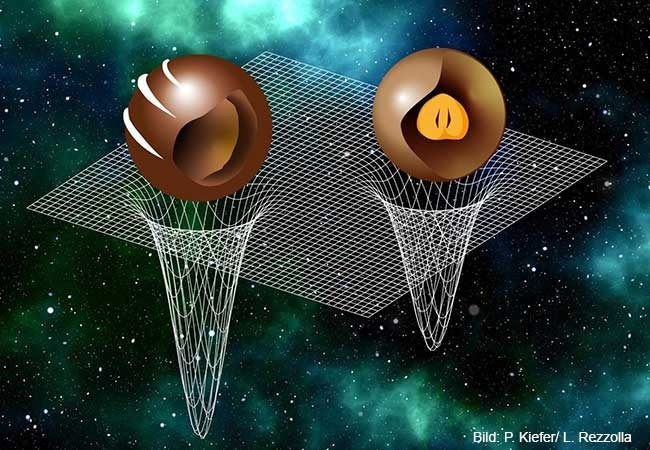Reviewed by Alex SmithNov 16 2022
Physicists from Goethe University Frankfurt have established broad findings concerning the internal structure of neutron stars, where matter can reach huge densities: the stars' cores can be either highly rigid or very soft, depending on their mass. The findings were published in two separate articles.
 The study of the sound speed has revealed that heavy neutron stars have a stiff mantle and a soft core, while light neutron stars have a soft mantle and a stiff core—much like different chocolate pralines. Image Credit: P. Kiefer/L. Rezzolla)
The study of the sound speed has revealed that heavy neutron stars have a stiff mantle and a soft core, while light neutron stars have a soft mantle and a stiff core—much like different chocolate pralines. Image Credit: P. Kiefer/L. Rezzolla)
Up until now, little was known about the inside of neutron stars, which are extraordinarily compact objects that can form after a star dies: the mass of the sun, or possibly more, is compressed into a sphere the size of a huge city. Researchers have been attempting to unravel its structure since its discovery more than 60 years ago.
The most difficult problem is simulating the extreme conditions within neutron stars, which are difficult to reproduce in a lab on Earth. As a result, there are numerous models in which various properties ranging from density to temperature are specified using so-called equations of state. From the stellar surface to the inner core, these equations attempt to explain the structure of neutron stars.
Physicists at Goethe University Frankfurt have now added more critical parts to the riddle. Professor Luciano Rezzolla’s group at the Institute of Theoretical Physics developed more than a million different equations of state that satisfy the constraints set by data obtained from theoretical nuclear physics on the one hand and by astronomical observations on the other.
When analyzing the equations of state, the study group found an unexpected discovery: “Light” neutron stars (with masses less than roughly 1.7 solar masses) appear to have a soft mantle and a stiff core, whereas “heavy” neutron stars (with masses greater than 1.7 solar masses) appear to have a stiff mantle and a soft core.
This result is very interesting because it gives us a direct measure of how compressible the center of neutron stars can be. Neutron stars apparently behave a bit like chocolate pralines: light stars resemble those chocolates that have a hazelnut in their center surrounded by soft chocolate, whereas heavy stars can be considered more like those chocolates where a hard layer contains a soft filling.
Luciano Rezzolla, Professor, Goethe University Frankfurt
The speed of sound, a study focus of Bachelor’s student Sinan Altiparmak, was critical to this discovery. This quantity measure emphasizes how fast sound waves propagate within an object and depends on how stiff or soft the matter is. On Earth, the speed of sound is utilized to investigate the planet's interior and discover oil reserves.
The physicists were able to discover previously unknown features of neutron stars by modeling the equations of state. For instance, regardless of mass, they almost certainly have a radius of only 12 km.
They have the same diameter as Frankfurt, the hometown of Goethe University.
Our extensive numerical study not only allows us to make predictions for the radii and maximum masses of neutron stars, but also to set new limits on their deformability in binary systems, that is, how strongly they distort each other through their gravitational fields. These insights will become particularly important to pinpoint the unknown equation of state with future astronomical observations and detections of gravitational waves from merging stars.
Dr. Christian Ecker, Study Author, Goethe University Frankfurt
Journal References:
Altiparmak, S., et al. (2022) On the Sound Speed in Neutron Stars. The Astrophysical Journal Letters. doi.org/10.3847/2041-8213/ac9b2a
Ecker, C. & Rezzolla, L. (2022) A general, scale-independent description of the sound speed in neutron stars. The Astrophysical Journal Letters. https://doi.org/10.3847/2041-8213/ac8674